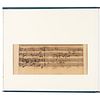Johann Sebastian Bach Handwritten Church Cantata Manuscript
Two ways to bid:
- Leave a max absentee bid and the platform will bid on your behalf up to your maximum bid during the live auction.
- Bid live during the auction and your bids will be submitted real-time to the auctioneer.
Bid Increments
| Price | Bid Increment |
|---|---|
| $0 | $5 |
| $50 | $10 |
| $200 | $25 |
| $500 | $50 |
About Auction
Apr 12, 2023
RR Auction support@rrauction.com
- Lot Description
Remarkable autograph musical manuscript by Johann Sebastian Bach, one page both sides, 7.75 x 6.25, no date but circa 1728, being a fragment from the church cantata Ich habe meine Zuversicht (BWV 188). This section is the lower half of folio 17 of the original manuscript, comprising bars 59b-66 and 73-76 of the 4th movement, scored for alto with cello and organ obbligato, on four systems of four hand-drawn staves. The present fragment comprises 11½ bars from the conclusion of the movement, including the words "‰Û_Seinen führt, unerforschlich ist die Weise, Wie der Herr die Seinen führt, unerforschlich ist die Weise, Wie‰Û_" The piece has been inlaid in a larger sheet and encapsulated in archival mylar; the lower stave is in very good condition with minor ink acidification, while the upper system is affected by heavy ink corrosion causing a number of cracks and losses, reinforced with early archival film (now toned). Displayed in a handsome custom-made blue morocco portfolio, with only the attractive lower half displayed.
Most likely composed for October 17, 1728 (or possibly November 6, 1729), BMV 188 is a cantata for the 21st Sunday after Trinity and uses text drawn from Picander. Bach wrote the piece in the key of E minor, which he frequently associated with the crucifixion. The ensemble is made up of four voices, two oboes, viola, organo obbligato and basso continuo. In the fourth movement, the dramatic heart of the cantata, the text "Unerforschlich ist die Weise" ("The ways of the Lord are past understanding," a meditation on the cross and human suffering) is elaborated as a dark, expressive aria for alto voice set against a virtuoso organ obbligato.
Bach's original manuscript for BMV 188 has suffered more vicissitudes than most, with the first 10 of the 18 leaves being lost at an early date (probably before the 1827 auction of the estate of Wilhelm Friedemann Bach), taking with them the great majority of the first movement. The remaining leaves are now widely scattered, with four leaves being cut up (as here) into two or even three pieces. Although the resulting fragments are now located in ten holdings in eight countries, they are nevertheless sufficiently continuous to enable the 2nd to 5th movements to be reconstituted. The present fragment, which comprises the lower half of fol. 17, is identified in the "Kritischer Bericht" of the Neue Bach-Ausgabe [New Bach Edition] as A14 ("unbekannter Privatbesitz"). The same source notes that the marked ink acidification which has affected the upper half of the present fragment is typical of the dismembered leaves, and is in part a result of the dense compositional script of the composer, in this instance with many tripletised semi-quavers.
Provenance: The autograph score of BWV 188 is thought to have been among a group of manuscripts inherited by Bach’s impecunious eldest son, Wilhelm Friedemann, and sold by him at auction in 1774. Parts of the Wilhelm Friedemann Bach estate were again auctioned in 1827, being acquired by the inventor and collector Carl Philipp Heinrich Pistor (1778-1847). Pistor’s manuscripts were inherited by his son-in-law, Adolf Friedrich Rudorff (1803-73), from whom they passed to the musicologist Friedrich Wilhelm Jähns (1809-88). The present leaf was one of four acquired from Jähns by the Viennese collector Gustav Petter (1828-68), who is thought to have been responsible for their dismemberment. The last owner of the present fragment traced by the "Kritischer Bericht" is Nora Kluge (née von Hase) of Lübeck, wife of the composer and musicologist Manfred Kluge (1928-71), probably inherited from her grandfather, Oskar von Hase (1846-1921), proprietor of the music publishers Breitkopf & Härtel. Sold at auction at Christie’s, 4 November 1981, lot 144, when it passed into the collection of the Canadian chemist and physician Frederick Lewis Maitland Pattison (1923-2010; his bookplate on the portfolio’s inside front cover); sold again at Christie's, 20 May 2014, lot 15. See: Neue Bach-Ausgabe (1997), Kritischer Bericht, A14. - Shipping Info
-
Bidder is liable for shipping and handling and providing accurate information as to shipping or delivery locations and arranging for such. RR Auction is unable to combine purchases from other auctions or affiliates into one package for shipping purposes. Lots won will be shipped in a commercially reasonable time after payment in good funds for the merchandise and the shipping fees are received or credit extended, except when third-party shipment occurs. Bidder agrees that service and handling charges related to shipping items which are not pre-paid may be charged to a credit card on file with RR Auction. Successful international Bidders shall provide written shipping instructions, including specified Customs declarations, to RR Auction for any lots to be delivered outside of the United States. NOTE: Declaration value shall be the item’(s) hammer price and RR Auction shall use the correct harmonized code for the lot. Domestic Bidders on lots designated for third-party shipment must designate the common carrier, accept risk of loss, and prepay shipping costs.
-
- Buyer's Premium



 EUR
EUR CAD
CAD AUD
AUD GBP
GBP MXN
MXN HKD
HKD CNY
CNY MYR
MYR SEK
SEK SGD
SGD CHF
CHF THB
THB
















